Behind the Finish: Maryse Robbins of Unchiffon fon fon
A true artisan in our space, Maryse explores the intersection of cartonnage and needlepoint–leading to stunningly beautiful finishes
Meet Maryse Robbins, the brilliantly talented French-born artist behind the beautiful cartonnage finishes featured on her Instagram profile. Also known as Unchiffon fon fon, get to know Maryse, how she began finishing needlepoint, and the story behind her finishes.
I’ll admit, it took me a good while to work up the guts to ask Maryse for this interview, as I really wanted to get it right. Maryse couldn’t have been more gracious with her time, she’s truly as lovely as her finishes are beautiful. Through the course of her conversation, I learned about her passion for her art, but also the beautiful connections she has with her clients. I hope you enjoy this interview.

Amanda: Let’s start with your journey into finishing. How did you begin?
I was teaching a cartonnage class at my local needlepoint shop and I overheard the managers talking about a finisher who was not producing good work. At this point, I didn’t even know what finishing was. After class, I asked my students what finishing was, and when they told me, it was a light bulb moment. So I spoke with the managers after my class and asked them if I could offer finishing services and before they even said yes, someone came up to me with a handful of canvases and said ‘I will be your guinea pig’. And that’s how I started.
Finishing is something that I’m still discovering every single day. It’s always moving, always changing. It is engineering. Every time it is new because of the dimensions of the subject and the customer’s vision for the project.
I try to figure out what I’m doing, but honestly, most of the time, I don’t know! I have to take pictures to make sure I remember the next project because everything happens in the moment.
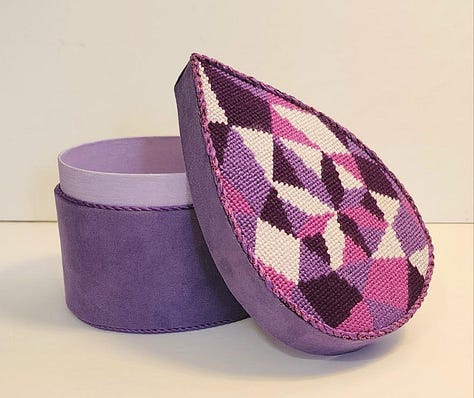
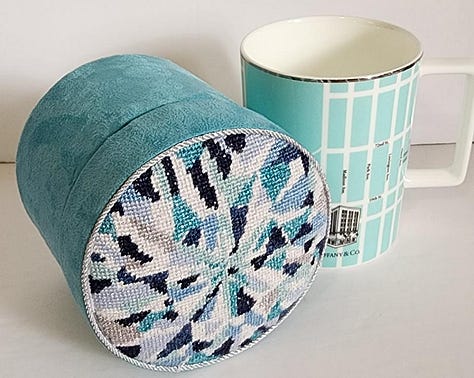
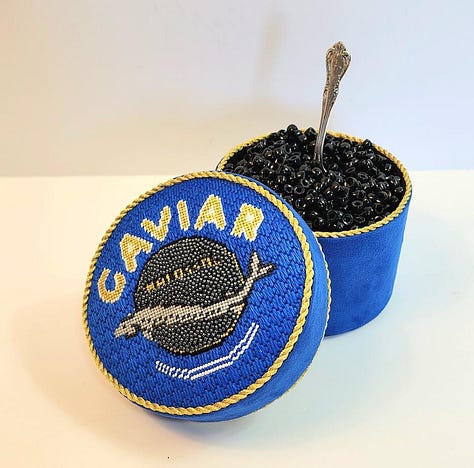
Amanda: That’s really interesting. It sounds like your process is very intuitive.
Maryse: Yes, it’s a lot of intuition, passion, and love. When I receive pieces from customers all over, most of the time I don’t know them yet. I look at the project and think, “Oh my gosh, what a wonderful challenge!” But I have to improvise. Every time. I know the ratios, the process, the mechanics, but the wonderful challenge to it is making that project very special. I want to create the vision of my customer.
Amanda: Stepping back for a moment—can you explain what defines the category of cartonnage?
Maryse: Cartonnage is the art of constructing objects out of paperboard. It’s about building structures—boxes, platforms, organizers. What you see on my [Instagram] page today is just the tip of the iceberg. Behind the scenes, I’m making countless photo boxes and custom pieces that don’t necessarily fit within the traditional needlepoint world.
Amanda: So you create cartonnage that are both functional and meaningful.
Maryse: Exactly! You could use them in a dining room to store placemats or in an office to organize stationery. I love making pieces that serve a purpose. I call this practical art. Everytime you use a jewelry box, a tissue box, you touch it and are reminded of your creation. What I’m doing serves a purpose and I think that’s why people like it so much.
And sometimes, my customers give me new ideas. They’ll say, “Can you do this?” And I never say no. I always say, “Let me think about it.”
Amanda: And that leads to even more creativity.
Maryse: Yes! I start brainstorming, exploring possibilities, and before I know it, I have a new idea to suggest.
Every project is different, which means pricing is always a challenge. I can tell you one thing—my first-time projects are always underpriced! I constantly underestimate the work involved.
Amanda: That makes sense—it’s hard to gauge the effort until you’ve done it.
Maryse: Exactly. But at the end of the day, I love creating all these things. That’s what matters most to me.
Amanda: I truly believe you’ve created a whole new category of finishing. Do you see it that way?
Maryse: I feel like I bring a mix of French and American traditions—maybe we approach things differently.
When I lived in France 30 years ago, I remember my grandmother framing her needlepoint because that’s all she was able to do. Finishing didn’t exist for this kind of work. I discovered the French part of making boxes (cartonnage) when I was already in the US, through a French friend. I loved it at first glance.
As hard as it looked at the start, I fell in love with needlepoint cartonnage immediately. I finally figured it out, and I had that moment where I said, "I saw the light." That was it, voila!
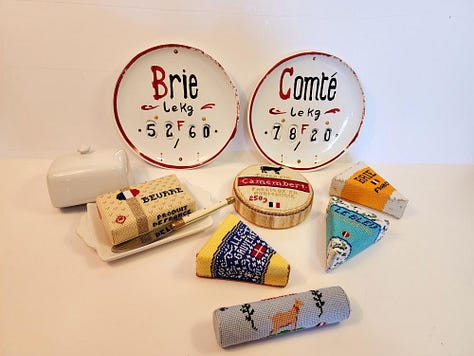
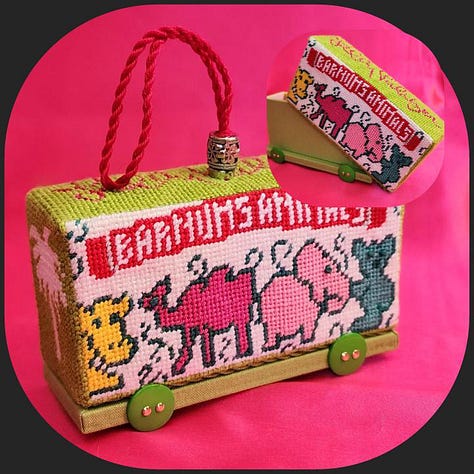
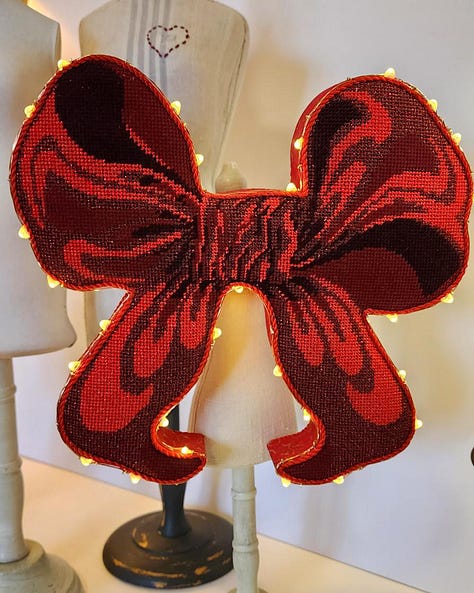
Amanda: You’ve mentioned being happy with your career, which is so wonderful to hear. You started this work later in life, didn’t you?
Maryse: Yes, I started at 60. In France, people would have looked at me as if I were crazy, but here in the United States, I had the freedom to start without facing the same judgment. I’m so grateful for that. You don’t need to be rich to begin; you just need the right identification and authorization to move forward. I’m really thankful for that.
Amanda: What would you say sets your work apart from other finishers you’ve seen?
Maryse: My work is almost always pretty minimalistic. it’s about focusing on the embroidery itself, not just the finish.
When you go to a museum, you don’t look at the frame first—you look at the artwork. That’s how I feel about needlework finishing. The embroidery should always be the focus.
And that’s why I’m so happy doing what I do. I just love it. And I think—well, I think people love it, too.
Amanda: I’d say so! Considering you sold out your entire year’s availability in what—just a few days?
Maryse: It was actually two weeks! In January—maybe the 15th or so—I looked at my list and thought, “That’s it. That’s all I can handle. I’m just one person.” I understand the frustration people feel when they can’t get something from me right away. But at the end of the day, this is my business, my life, my reputation.
You can build a business very quickly, but you can also destroy it just as fast. And I don’t want that to happen.
Amanda: That’s a great mindset.
Maryse: I know it might sound simplistic, but it’s the truth. When I share my work—especially with customers across the U.S.— and they send me messages about how happy they are, that’s what truly matters. That’s what keeps me going.
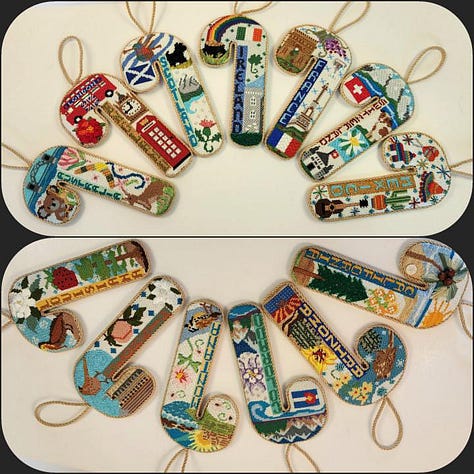
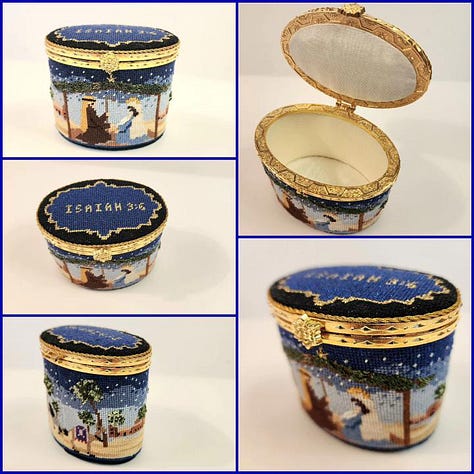
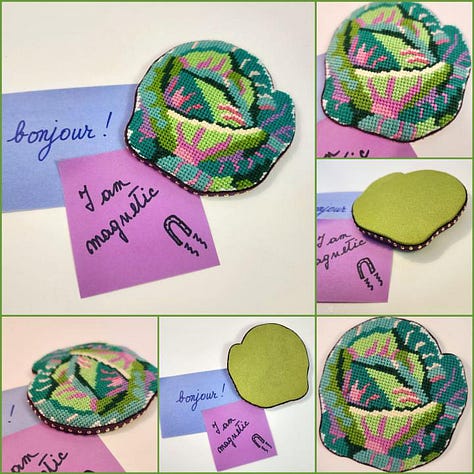
Amanda: Do you think there’s a right or wrong way to finish?
Maryse: No. You have to know what you're doing, but at the same time, it’s about what your abilities are. For a long time, people would say, “Oh, finishing with glue is no good.” But that’s how I do it! There are different styles, different fashions in finishing. Some say you must do it one way, but that’s not true. It’s an art and nothing is written in stone!
Amanda: I think that's a really valid point. When I first started finishing ornaments, I used hot glue. But it was so messy that I switched to an acid-free tacky glue. Eventually, I realized I preferred sewing because I'm not very precise or careful. Sewing allows me to undo my mistakes—it’s more forgiving.
Maryse: You are perfectly right with hot glue but you can do the same thing with regular glue with the right techniques. You can adjust everything. But you have to know so many things—the quality of the fabric, how much glue to use, how it absorbs into different materials. Sometimes you have to build up layers, and sometimes you just need to introduce the glue to the fabric without oversaturating it.
That’s why every time I finish something, I learn something new. No two projects are identical.
Amanda: Do you have any advice for folks who are interested in trying cartonnage?
Maryse: Try, try, try. Take your measurements, think twice, and go slowly. Very slowly. It’s not complicated, but it’s tedious. You need to get the right angles, and make sure your cardstock is good. It’s a craft that takes time and patience.
Amanda: It’s an art form, for sure.
Maryse: Yes, it’s definitely an art. It’s not something you rush. When you do something like this, it’s expensive because creating the box could take 10 to 30 hours. It’s not something you just throw together in a few minutes.
Amanda: And the price reflects that, right?
Maryse: Yes, exactly. It’s not expensive; it’s priced correctly for the craftsmanship. There's a lot of human work behind it — a lot of blood, sweat, and tears. Believe me, I can tell you that. But in the end, there’s so much joy and happiness in what you create. That’s why I think pricing it properly is so important. It’s about the quality of the craftsmanship.
Amanda: So, I have to ask, what's your favorite finish that you've done?
Maryse: I’d say the last one and the next one. I love all of them. Doesn’t matter the subject, I love them all. And you know why? I talk with my customers a lot, I know what they like, what’s okay for them or not.
They all call me, even if they don’t have a project at the moment. And we start to build this relationship. They’ll say, "I'm thinking of this color," and I’ll work with them on their ideas. When I receive their project, I’ll call them and say, “Okay, now I get it. We can do this and that.” I may not draw perfectly, but they can see what I imagine. And most of the time, they say, "Just do it." There’s a beautiful trust that develops.
Amanda: I love that! It’s like they trust your artistic vision.
Maryse: Yes, exactly. It's like I'm a witch or something, working with all these materials to create something magical! The relationships are so meaningful. I’ve even had customers tell me they want to be buried with the projects I've finished for them—it’s just so touching to see how much they cherish the work. And this is the magic of what we do. It’s priceless, and no store could ever replicate that kind of bond.

Amanda: That’s truly beautiful. I think a lot of people don't realize how deeply people connect to needlepoint and other handmade crafts. It’s incredible that you can create that kind of impact with your work.
Maryse: Yes, absolutely. It’s about more than just the finished product. It’s the connection you build, the care that goes into each piece, and the way it becomes part of someone’s life. That’s what makes it special.
Amanda: Absolutely. I think that’s what makes your work so special—the dedication and the constant striving for improvement. It’s been so wonderful speaking with you, Maryse. I’m sure this interview will inspire many people.
Maryse: Thank you, Amanda. It’s been such a pleasure to share my thoughts and my journey. It’s not every day I get to talk about the process and the passion behind what I do. Thank you for the opportunity.
To see more of Maryse’s beautiful work, visit her Instagram page.
Behind the Finish is a project dedicated to the celebration of inspiring finishes and the people behind them. View the archive here.
If you know of someone who would make a great feature, please email finishingfairy@gmail.com or message me here on Substack.
Left Inspired? Please consider sharing.






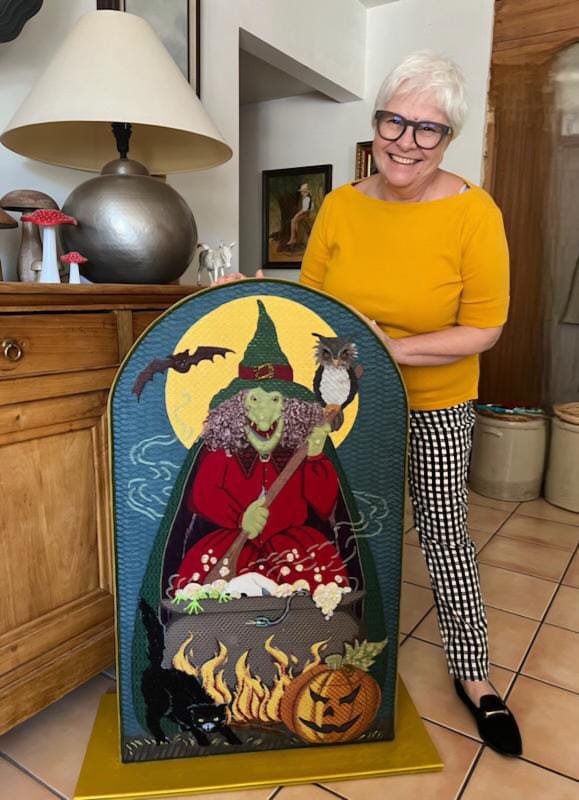



I loved this interview and learned so much!! Thank you, Amanda!
Love this. She’s iconic!